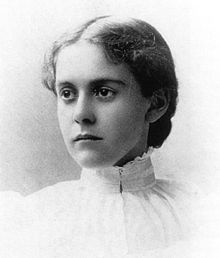BURIED TOGETHER
Queer Places:
Miss Porter's School, 60 Main St, Farmington, CT 06032, Stati Uniti
Johns Hopkins University, Baltimore, MD 21218, Stati Uniti
Harvard University (Ivy League), 2 Kirkland St, Cambridge, MA 02138
University of Michigan, Ann Arbor, Michigan, Stati Uniti
Hull House, 800 S Halsted St, Chicago, IL 60607, Stati Uniti
159 Ferry Rd, Lyme, CT 06371, USA
Cove Cemetery, 97 CT-148, Lyme, CT 06371, USA
 Alice Hamilton (February 27, 1869 – September 22, 1970) was an
American physician, research scientist, and author who is best known as a
leading expert in the field of
occupational health and a pioneer in the field of
industrial toxicology. She was also the first woman appointed to the
faculty of
Harvard University. Her scientific research focused on the study of
occupational illnesses and the dangerous effects of industrial metals and
chemical compounds. In addition to her scientific work, Hamilton was a
social-welfare reformer, humanitarian, peace activist, and a
resident-volunteer at
Hull
House in Chicago. She was the recipient of numerous honors and awards,
most notably the
Lasker Award for her public-service contributions. Interrogated in her 90s
about the nature of the relationships enjoyed by women at Hull-House, Alice
Hamilton said there was no open lesbian activity, but she went on to point out
that the very question presupposes a preoccupation with sex that would have
struck the women of Hull-House as strange.
Alice Hamilton (February 27, 1869 – September 22, 1970) was an
American physician, research scientist, and author who is best known as a
leading expert in the field of
occupational health and a pioneer in the field of
industrial toxicology. She was also the first woman appointed to the
faculty of
Harvard University. Her scientific research focused on the study of
occupational illnesses and the dangerous effects of industrial metals and
chemical compounds. In addition to her scientific work, Hamilton was a
social-welfare reformer, humanitarian, peace activist, and a
resident-volunteer at
Hull
House in Chicago. She was the recipient of numerous honors and awards,
most notably the
Lasker Award for her public-service contributions. Interrogated in her 90s
about the nature of the relationships enjoyed by women at Hull-House, Alice
Hamilton said there was no open lesbian activity, but she went on to point out
that the very question presupposes a preoccupation with sex that would have
struck the women of Hull-House as strange.
Alice was the second oldest of five siblings that included three sisters (Edith,
Margaret, and
Norah) and a brother (Arthur "Quint"), all of whom were
accomplished in their respective fields. The girls remained especially close
throughout their childhood and into their professional careers.[5]
Edith (1867–1963), an educator and headmistress at
Bryn Mawr School in
Baltimore,
Maryland,
became a classicist and renowned author for her essays and best-selling books
on ancient Greek and Roman civilizations. Margaret (1871–1969), like her older
sister Edith, became an educator and headmistress at Bryn Mawr School. Norah
(1873–1945) was an artist. Arthur (1886–1967), the youngest Hamilton sibling,
became a writer, professor of
Spanish, and assistant dean for foreign students at the
University of Illinois at Urbana-Champaign. Arthur was the only sibling to
marry; he and his wife, Mary (Neal) Hamilton, had no children.[12]
.JPG)
Hull House
In 1897 Hamilton accepted an offer to become a professor of pathology at
the Woman's Medical School of
Northwestern University. Soon after her move to Chicago, Illinois, she
fulfilled a longtime ambition to become a member and resident of
Hull
House, the
settlement house founded by social reformer
Jane
Addams and
Ellen Gates Starr.[3][5][22]
While Hamilton taught and did research at the medical school during the day,
she maintained an active life at Hull House, her full-time residence from 1897
to 1919.[23]
Hamilton became Jane Addams' personal physician and volunteered her time at
Hull House to teach English and art. She also directed the men's fencing and
athletic clubs, operated a well-baby clinic, and visited the sick in their
homes.[24][25]
Although she had moved away from Chicago in 1919 when she accepted a position
as an assistant professor at
Harvard Medical School, Hamilton returned to Hull House and stayed for
several months each spring until Addams's death in 1935.[23] Using today’s terminology, many Hull House residents would be described as lesbians. In 1963—when Alice Hamilton was in her 90s—the biographer Allen F. Davis asked her about the nature of female relationships at Hull House. He wrote: She denied that there was any open lesbian activity involving Hull House residents, but agreed that the close relationship of the women involved an unconscious sexuality. Because it was unconscious it was unimportant she argued. Then she added with a smile that the very fact that I would bring the subject up was an indication of the separation between my generation and hers.
Alice Hamilton met
Charlotte Perkins Gilman in Chicago in the winter of 1898, noting in a
letter to her sister that ‘Mrs. Stetson … is very attractive. She is the
woman … who couldn’t stand being married … and now is on excellent terms
with her former husband and his present wife, who takes care of Mrs.
Stetson’s little girl, an arrangement which I fancy I should approve of.’
After her retirement from Harvard in 1935, Hamilton became a medical
consultant to the U.S. Division of Labor Standards.[51]
Her last field survey, which was made in 1937–38, investigated the viscose
rayon industry. In addition, Hamilton served as president of the National
Consumers League from 1944 to 1949.[25][45]
Hamilton spent her retirement years in
Hadlyme, Connecticut, at the home she had purchased in 1916 with her
sister, Margaret. Hamilton remained an active writer in retirement. Her
autobiography, Exploring the Dangerous Trades, was published in 1943.[52]
Hamilton and coauthor Harriet Hardy also revised Industrial Toxicology
(1949), the textbook that Hamilton had initially written in 1934. Hamilton
also enjoyed leisure activities such as reading, sketching, and writing, as
well as spending time among her family and friends.[45][53]
Clara Landsberg was a close college and
longtime family friend, studied in Europe with Margaret Hamilton for a summer
in 1899. The daughter of a
Reform rabbi from
Rochester, New York, and a graduate of Bryn Mawr College, Landsberg became
a resident at Hull House, where she was in charge of its evening education
programs and shared a room with Alice. Lands berg eventually left Hull House
to teach Latin at Bryn Mawr School in Baltimore, Maryland, where Edith was
headmistress. Margaret also became a teacher at Bryn Mawr School and took over
as headmistress before retiring in 1935. Alice, who considered Landsberg part
of the Hamilton family, one remarked, "I could not think of a life in which
Clara did not have a great part, she has become part of my life almost as if
she were one of us."
Hamilton died of a stroke at her home in
Hadlyme, Connecticut, on September 22, 1970, at the age of 101.[5][54]
She is buried at Cove Cemetery in Hadlyme with her sister and Claura Landsberg.[55][56]
Hamilton was a tireless researcher and crusader against the use of toxic
substances in the workplace.[57]
Within three months of her death in 1970, the
U.S. Congress passed the
Occupational Safety and Health Act to improve workplace safety in the
United States.[58]
My published books:


BACK TO HOME PAGE

- https://en.wikipedia.org/wiki/Alice_Hamilton
- Oakley, Ann. Women, Peace and Welfare . Policy Press. Edizione
del Kindle.
 Alice Hamilton (February 27, 1869 – September 22, 1970) was an
American physician, research scientist, and author who is best known as a
leading expert in the field of
occupational health and a pioneer in the field of
industrial toxicology. She was also the first woman appointed to the
faculty of
Harvard University. Her scientific research focused on the study of
occupational illnesses and the dangerous effects of industrial metals and
chemical compounds. In addition to her scientific work, Hamilton was a
social-welfare reformer, humanitarian, peace activist, and a
resident-volunteer at
Hull
House in Chicago. She was the recipient of numerous honors and awards,
most notably the
Lasker Award for her public-service contributions. Interrogated in her 90s
about the nature of the relationships enjoyed by women at Hull-House, Alice
Hamilton said there was no open lesbian activity, but she went on to point out
that the very question presupposes a preoccupation with sex that would have
struck the women of Hull-House as strange.
Alice Hamilton (February 27, 1869 – September 22, 1970) was an
American physician, research scientist, and author who is best known as a
leading expert in the field of
occupational health and a pioneer in the field of
industrial toxicology. She was also the first woman appointed to the
faculty of
Harvard University. Her scientific research focused on the study of
occupational illnesses and the dangerous effects of industrial metals and
chemical compounds. In addition to her scientific work, Hamilton was a
social-welfare reformer, humanitarian, peace activist, and a
resident-volunteer at
Hull
House in Chicago. She was the recipient of numerous honors and awards,
most notably the
Lasker Award for her public-service contributions. Interrogated in her 90s
about the nature of the relationships enjoyed by women at Hull-House, Alice
Hamilton said there was no open lesbian activity, but she went on to point out
that the very question presupposes a preoccupation with sex that would have
struck the women of Hull-House as strange..JPG)

